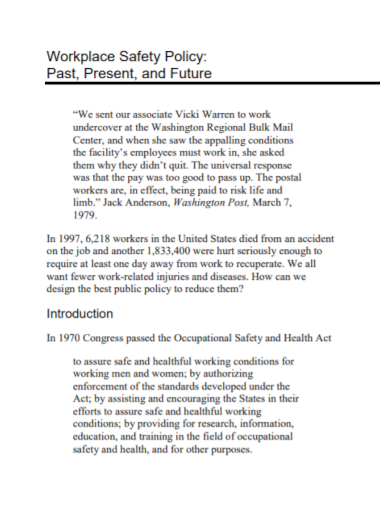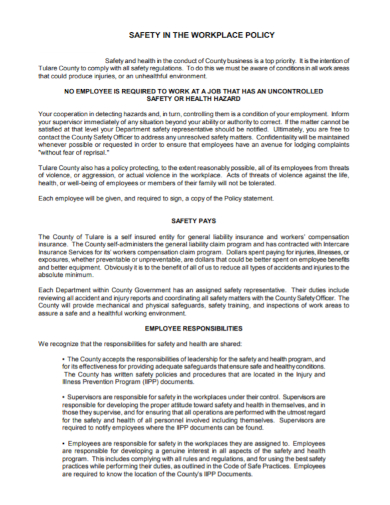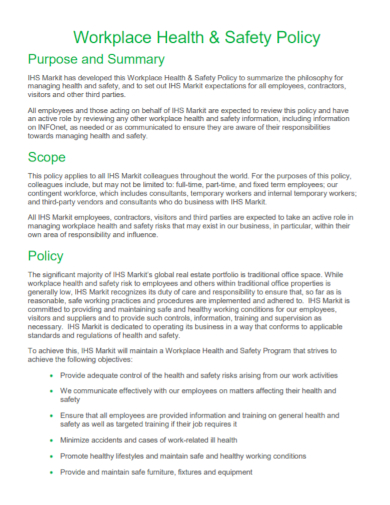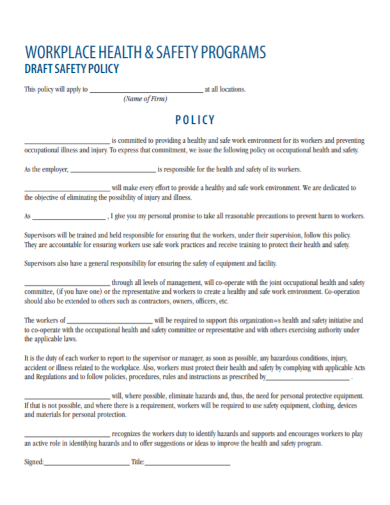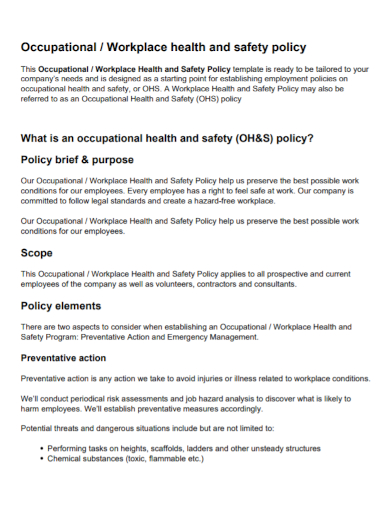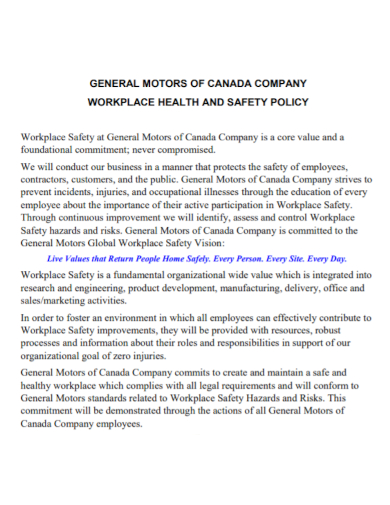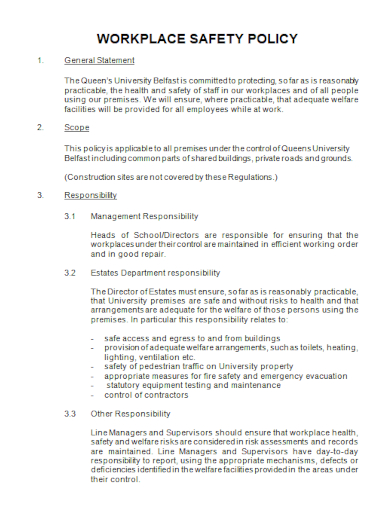In this day and age, health and safety has become a number one priority in most places especially in a business organization. With a lot of things going on in society, it is important that companies implement workplace policies that would safeguard not only the health but the well-being of their employees and company as a whole. Well written policies help management manage their staff more effectively defining acceptable and unacceptable behavior in the workplace, and set out the implications of not complying with those policies. To know more please check out our various workplace safety policy samples below:
10+ Workplace Safety Policy Samples
1. Workplace Safety Policy
2. Sample Workplace Safety Policy
3. Standard Workplace Safety Policy
4. Safety Policy for Workplace
5. Workplace Safety Management Policy
6. School System Workplace Safety Policy
7. Workplace Health and Safety Policy
8. Workplace Health and Safety Program Policy
9. Occupational Workplace Health and Safety Policy
10. Company Workplace Health and Safety Policy
11. Editable Workplace Safety Policy
What Is a Workplace Safety Policy?
A policy is defined as a set of guidelines or rules which is adopted a followed by an organization, government, groups and individuals as well. In a workplace, policies are based on how employee and well as company issues are dealt with. These communicates the company’s values and expectations of employee behaviors and performance and health and safety that suits the nature and scale of your organization’s risks. Procedures are in place which set out the steps workers should follow to perform specific work activities safely and meet organizational policies. An example of workplace policies are anti-harassment policy, employee complaint policy, health and safety policy and dress code policy among other things.
How to Develop Workplace Policies?
A clear-cut workplace safety policies and procedures help management with its decision-making to make sure that integrity and fairness are adhered to when issues arise. As well as help minimize legal and safety risks for you and your business. These serves as intermediary between a business’ vision and values and its day to day operations. New employees are often introduced to these policies during orientation and specific action plans are included in these procedures as well. To be able to create a well-written workplace policy, here are some tips to consider:
I. Top Management Involvement
To set these policies in motion will require the full support of the top management which in fact if these are endorsed by senior staff will serve as a good role model for others to follow. Writing policies is not just a the responsibility of a single entity but for the whole business organization.
II. Employee Awareness
One of the main reasons that workplace policies are created is because of the employees. Ensure that company employees are aware and understand what these policies entails by clearly explaining what they are and if breached there would be dire legal consequences. Include an introduction or reminders of these policies during employee trainings and printed in an employee handbook or manual for easy access. Staff involvement also helps to determine how and when the policies might apply, and can assist in identifying possible unintentional outcomes of the policy.
III. Identify and Summarize the Policies
Although there are a lot of things we want to include and explain in drafting policies, it would be easier for staff to grasp and understand it if these are direct to the point and brief. A policy should also contain procedures to support the policy in its operation, such as the implications for not complying with the policy. Lastly there are some policies that relate to a specific job or worker, make sure to be clear about who the policy applies to.
IV. Document These Policies
As mentioned, company policies must be included in an employee’s handbook or manual. These should be publicized and easily accessed to any members of the organization. Ensure all staff understand what the policies mean. Any written hard or soft copies of these policies can serve as easy reference should any safety-related incidents or workplace harassment occur which can affect overall productivity, quality of work, and employee morale. And policies are effective tools if there is a need for an investigation.
V. Updates
In this changing times where new incidents occur everyday, management must also keep in mind to update their policies to adapt to the present circumstances. This may be caused by environmental, human-related or health issues. Review policies regularly to ensure they are current and in line with any changes within the organization.
VI. Strict Implementation
Make sure to strictly implement these policies to the whole organization and that no one is exempted unless stated otherwise. Policies would not serve its purpose if a company remains negligent and careless. Workplace safety policies are often developed in response to hazard and risk assessments
FAQs
Who Is Responsible for Company Policies?
Company policies and procedures are developed from a company vision and objectives, which are usually formed in strategic management meetings at the top level of the organization.
What Is an Employee Handbook?
An employee handbook or manual is a physical or digital copy which contains a company’s mission, policies and expectations.
What Is a Human Resource Department?
This is a company division who is in-charge for managing the employee life cycle, administering employee benefits and keeping up to date with any laws that may affect the company and its employees.
To create a healthy working environment with happy and productive employees can only be achieved when there is a set of guidelines that would maneuver an organization to a positive direction. Policies and procedures are established to make sure a company is living a well maintained and balanced work life.
Related Posts
FREE 11+ Safety Audit Report Templates
FREE 10+ Contractor Management Procedure Samples
FREE 10+ Contractor Handbook Samples
FREE 10+ Construction Health And Safety Plan Samples
FREE 10+ Fire Risk Assessment Samples
FREE 9+ Sample Safety Statement
FREE 8+ Safety and Health Training Plan Samples
FREE 5+ Safety Contract Samples
FREE 18+ Safety Agenda Samples
FREE 16+ Construction Safety Plan Templates
FREE 10+ Workplace Inspection Checklist Samples
FREE 10+ HR Assessment Checklist Samples
FREE 9+ Safety Contract Samples
FREE 8+ Contractor Management Policy Samples
FREE 8+ Sample Accident Release Forms

